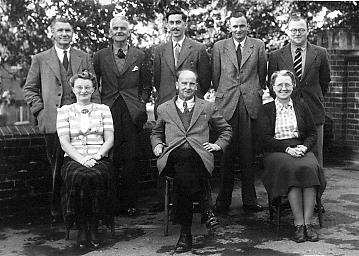St John's School
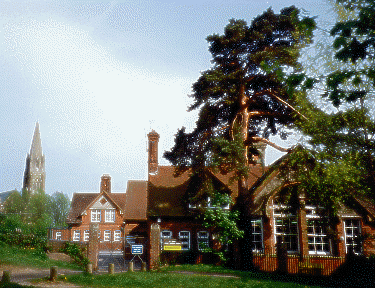 |
|||||||||||||||||
The upper building of St John's School as it was before 1910 and as it is today
The History of St John's School,
Pendleton Road, Redhill, The history of St John's School began on 21st August 1840 when a decision was taken at a parish vestry meeting to claim compensation from the Brighton, London and South Coast Railway Company for the loss of grazing and other rights when it built the railway across common land in the Manor. Four years later the churchwardens were holding a meeting to decide what to do with £535.7s thus obtained. The decision was to spend one third of it on the poor rate and two thirds on building a National Schools at St John's. The Schools (Boys', Girls' and Infants') opened in 1845 and St John's, now in the form of a Community Primary school, is still going strong.
|
|||||||||||||||||
|
The
building of the original school in 1845 |
|||||||||
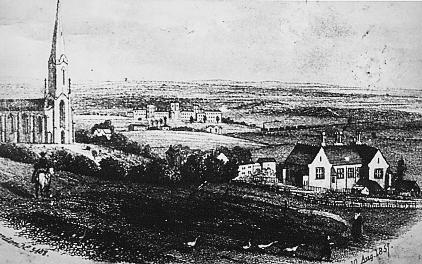 |
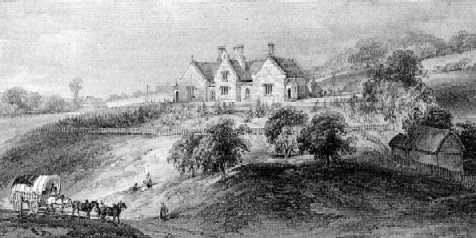 |
|
| These views, the first from the common, the second from St John's Church, show what the School looked like when it was first built. The school building seen here is where today's upper building is. Who the builder was is not known. In the picture on the left St John's Church is on the left of the picture and in the centre is the Royal Earlswood Asylum. Just visible between the school and the Asylum is a tall funnelled train on the railway line that provided some of the money to build the school. In the picture on the right the horsedrawn wagon is on what is today Pendleton Road. None of this building remains today. | ||
| The building of the lower part of the School | ||
| Because the Church had been involved with
the meetings and the money to build the School the Church
also ran the School. Because the population continued to
grow the school had to be made bigger from time to time
and the Church had to find the money for this. Sometimes
it could not afford to improve the school or even to make
necessary repairs. The Government said that if the School
was not looked after properly it would take the School
away from the Church and run it itself. People were
concerned that their children would not get the religious
instruction they wanted. Lots of meetings were held and
eventually £1500 was raised by door to door collections
in Reigate. With this money the lower building we see
today was built and opened in October 1884. The architect
- the man who designed the new building - was Mr
Haughton. He had recently built a new school at East
Grinstead but where he lived is unknown. Once again, the
builder is also unknown. Up to now the boys and girls had all been in the one building. Now the new, lower building became the Boy's School and the infants and girls stayed in the old building. |
||
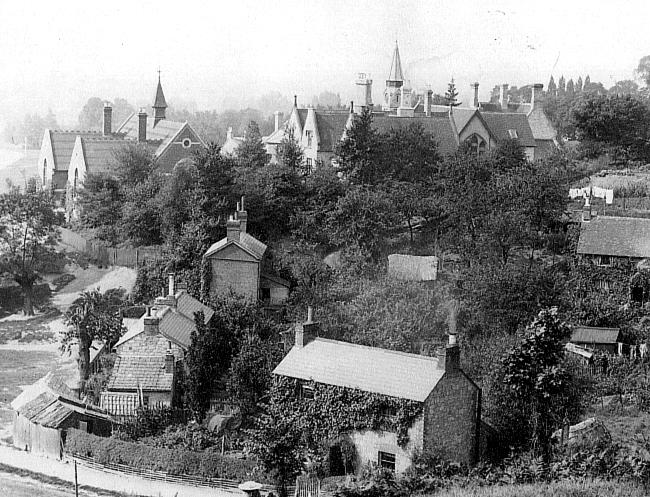 This
wonderful view taken from St John's Church shows how St
John's had grown from the small isolated building above
into a large group of buildings. In the foreground are
cottages in Pendleton Road. At the top centre of picture,
just left of the pointed clocktower, is the original
building. On the top left of picture is the lower
building that was put up in 1884 and still stands today.
Behind the original building, and to the right of the
clocktower, are the buildings put up in and around 1861
to enlarge the school. All this cluster of buildings was
demolished and replaced by the upper building we have
today
This
wonderful view taken from St John's Church shows how St
John's had grown from the small isolated building above
into a large group of buildings. In the foreground are
cottages in Pendleton Road. At the top centre of picture,
just left of the pointed clocktower, is the original
building. On the top left of picture is the lower
building that was put up in 1884 and still stands today.
Behind the original building, and to the right of the
clocktower, are the buildings put up in and around 1861
to enlarge the school. All this cluster of buildings was
demolished and replaced by the upper building we have
today |
||
| On the left is the entrance to the old school building under the clock tower, but exactly where was it in relation to the school as we know it today. In the wonderful old picture on the right it can be seen that it was on the south side of the school close to the part of the common that is the car park today. The house was built for the occupation of the master of the school. Note the orderly line of girls entering the playground. | ||
| Some of the boys on Empire Day 1911 | The Girls on Empire Day 1911. There are about 400 girls here. In those days the school was much fuller than today when the number on roll for the whole school is around 200 | |
| The re-building of the upper part of the School | ||
....,,In the infants' part of the new school there were four classrooms (there are only three today). The girls' school had a hall and six classrooms (today only three are in use for boys and girls). One classroom was for 60 children, one for 40 and four for 50, so it can be seen that there were 300 children being taught where 90 are taught today. As there were also about 200 infants the playground was either very crowded at times, or separate playtimes were enjoyed - think of the noise outside when others were having lessons - or children were allowed out onto the common. The Surrey Mirror newspaper headline for the report of the opening of the school in 1910 read: 'Palatial New Buildings Opened at Redhill'. Compared to the old they probably were palatial, having gas and electricity, more light and better heating. It is interesting to note that these new buildings are now more than 91 years old - in 1910, when the old buildings were demolished some were 65 years old and some were less than 50 years old. .Although now showing its age in many ways the 'new' building has served the school well. The clock tower being built in 1910
St John's boys in 1889. The man is headmaster Mr Jinks. Notice that the information about the picture is displayed in front of the boy' cricket bats on a slate Classrooms
must have changed enormously over the years. In
1910 the school was rebuilt and today's classrooms are
much the same now as they were then but before that date
there was a different building on the site. As far as I
know there are no pictures of the classrooms in that
building must they were lit only by gas lamps that did
not give enough light to read by when it got dark on
winter afternoons. In cloakrooms there were no lights at
all so the children had to collect their coats before in
got too dark to find them. A picture of the old building
is at the bottom of the home page on this site. Assemblies were very much like today with the children being brought together regularly, but whether they were always every day is not known. The school we have today was originally built with no dividing screens in the hall, these were added later because sometimes three classes were being taught in them all at once, not a good idea because of the noise of one class disturbing another. In the present school building the screen between the stage and the TV room is sometimes moved back but the one blocking the year 6 classroom from the hall is always closed so perhaps many children have never realised that it was once a movable screen at all. In the lower building they have since been removed. A class of children at St John's in 1901. The name of the teacher is not known Air raid shelters were used a great deal by St John's children, especially in 1940-41 when the bombing was at its height. They were damp and ill-lit and not good places to be in for a long time. The children went into them when the sirens sounded the alert (an up and down sound of the sirens) and they lost a lot of their lesson time. Sometimes they had to remain in them after going home time if the all clear (a steady siren note) had not sounded by then. There is more about WW2 below. Pupils
who became well-known In this picture of the St John's
football team Charlie Pearce is second Fleur Adcock OBE, a
prominent poet of our time, had been a pupil at St John's
during WW2. She had fond memories of her old school and
wanted to make a return visit. She had returned in the
1970s when school was closed, had peered through the
railings and, following this visit, had written and
published a poem about the School. Fleur Adcock came
again to St John's (this time as an invited guest when it
was open) on November 16th, 2000. She was able to look
around the school, talk to parents and staff and take a
special assembly. It was a very memorable day for all
concerned. School Dinners |
||
Reminiscences of
Alan Moore - Pupil 1943 - 1950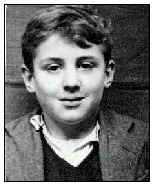 Early Days Early Days.......Unfortunately my own memories of St John's are less sharp than I would have wished but I clearly remember my first day and mother leaving me at the gates in a state of total distress - mine not hers - and spending some time sat outside the front door of the school with five or six like-minded other first-day children howling my eyes out. The sun was shining and we made a little wailing row (read that last word either way) on a long, low bench. That's where the memory ends. I must have eventually been enticed into the building but what happened inside I don't know. .....Eventually we were let out - to play I afterwards found out - but I went home. Mum brought me back and it was explained that I was supposed to stay in the playground and return to lessons until dinnertime. After dinner there was more play and more lessons. I was appalled. This meant I had to stay at that place ALL DAY! And I wanted my tricycle. .....Anyway, I understood the procedure. The next day I went back to school. I didn't cry this time but went into lessons. We were let out to morning play and I went home. After that I had a chaperone, a girl who held my hand all playtime so I didn't do a runner. I've no idea who she was but she probably hated the arrangement as much as I did. How long were joined at the hands during playtimes I don't remember, but I must have eventually conformed to the system and gained my freedom - at playtimes at least. .....Not that going home at the right time was always a good experience. The Walker twins were giving me a bit of a going over just outside the gates one day when I caught sight of my father arriving to collect me. I reckoned that when he got hold of those two my troubles were over. Boy, was I wrong! It turned out that his idea of a good object lesson was for me to get out of trouble on my own. It worked well. I got beaten up but found out that relying on others was not always a good idea, something that's come in handy from time to time. ....One thing I view with mixed feelings was joining a gang in my first month in the infants. I don't think I knew what a gang was when I was asked," Do you want to join my gang?" I answered in the affirmative and I was in - as easy as that. The good thing about it was that after school we - that's me and the rest of the gang - ran all over the place, finding new places and new things to get up to. Sometimes it got dark before I went home, and that was in the summer. The bad thing was that it was divisive, I mixed with a certain clique and not with the others. Mind you, getting beaten up by the Walker twins turned out well. They weren't in my gang - they were in anyone's gang, they were a gang on their own - but they seemed to take to me and were quite benevolent. When I lost all my cigarette cards they'd get me more. (Cigarette cards came in sets and boys played a win or lose game with them - I mostly lost) They gave me a whole set of sailing ship cards once. Probably they took them off other kids. Getting to School .I lived in Upper Bridge Road, Redhill and so had a walk over the top common to school and back each day. We were were not very often met so we walked either alone or with other boys or girls. A friend, a girl, lived in Ridgeway Road so I often used to walk to with her. Sometimes my Dad would take me to school on the crossbar of his bike. He was a fireman at Redhill fire station and work 24hr shifts so could only do this every other day. After school I ran all over the common and local area with other boys and often didn't get home until gone 6pm. Things were much freer and easier in those days. .......My teachers in the infants' School were all ladies. Miss Pickup, Miss Agate and others. The Headmistress of the Infants' was Miss Faulkner. I think I was in awe of them and probably obeyed them a great deal more than I did my own mother..I knew my place at school. The big people told the little people what to do and they did it. But there were differences in instruction that meant something. "Open your books at page......; " "Copy this down"; "Stop talking at the back"; these were orders. "Alan, get the reading books out and put one on every desk"; "Alan, see if you can open that window a little more for me"; these were almost requests for assistance. And, "Alan, we've collected a whole sackful of silver bottle tops now; on your way home on your bicycle drop them in at the East Surrey Hospital" was an order that filled me with pride that it was I who was chosen for such an important task. Of course, I knew I was the one who lived the nearest to the hospital, and when I got there the fact that I was greeted with. "More bottle tops? Doesn't the school know we don't want them any more?" took the shine off it a little (Although silver foil and bottle tops were collected in later years towards guide dogs for the blind) but it couldn't spoil all the pleasure of being of such sterling service to such an important person as a Teacher. School Plays I was in a play once. My entrance was marked by my tripping on the top step up to the stage in the school hall and sprawling full length and flat on my face in front of everyone, and there seemed to be millions of people in the audience. My performance was similarly marked by referring to the object that sat stage centre for the whole play, and was supposed to be magic stone, as a stove. The script I'd learnt was hand written and the N looked like a V. The Boys' School in the Lower Building After the Infants' I went to the Boys' School, which was in the lower building. This had its own Headmaster, Mr Bennett, who had a secretary called Miss Willet. They shared an office just inside the front door of the lower building, an area now part of the nursery. The Cane When I was at school the cane was given only for misbehaviour in school time or very close to school time. Years ago boys were caned if they were seen smoking on a Saturday or Sunday. This was when boys and girls stayed at St John's until they were fourteen. Corporal punishment was administered almost always, in my recollection, only by the Headteacher. Mr Bennett had a cane on the wall in his office; my memory is crystal clear on that, as is the memory of many other boys on that subject. I've been in his office a few times when it wasn't on the wall but in his hand. Once that point in an interview with the Head had been reached the smaller of the people present knew it was going to be used and it was going to hurt - a lot. Regardless of the offence, the only worthwhile strategy employ was that of saving face during the administration of the punishment. This was achieved by firmly holding out each hand in turn for the requisite number of strokes, usually three, while fixing the Head firmly and unblinkingly in the eye and showing no emotion. This was actually quite difficult because his eye was on your outstretched hand. Miss Willett's desk was in Mr Bennett's office; she was his secretary; sometimes you could fix her in the eye instead of him. I used to think it unnerved her slightly but no doubt was kidding myself. .....When all six strokes had been administered the Head would dismiss the subject of his corrective efforts. I don't know what other boys did but I would walk steadily to the door, open it, step outside, close the door firmly, carefully check that no-one else was around and then, thrusting throbbing fingers under opposite armpits, hop about muttering expletives until either someone came along and interrupted me or the pain subsided sufficiently for normal progress to be made back to class. There, entrance would be made and seat taken as though the trip to the head 's office had been simply to receive congratulations on how well my studies were progressing. .....Not all children could accept such punishment, some being reduced to pre-cane tears in anticipation of the pain to come. Corporal punishment, as we all know, is now not carried out in schools. I've been asked several times if it did me any harm. The answer is no. Did it do me any good? I certainly didn't go home and tell my parents about it because more displeasure - all directed at me - would have been incurred, and therein lies the difference between then and now. .....Mind you, getting the cane was sometimes a matter of chance, a phenomenon of school life whereby there were those who got the cane and were not particularly surprised to do so (and who incurred repeat doses) and those who did not and would have been most outraged if they did. There was no gulf between these two groups, merely a matter of pure chance, luck or fate that somehow guided one set of feet on a path of righteousness, and the other set on the one to the Head's office door. .....I certainly remember having the cane. I think we had one stroke on each hand for one offence. I was certainly adjudged guilty of more than one offence because I had to make the trip to Mr Bennett's office a number of times. This doesn't mean that I was a bad boy, just ordinary, really. And my offences were not terrible ones, they were talking in class when I shouldn't have done, and things like that. ......Sometimes I was simply in the wrong place at the wrong time. One day I was walking home up Pendleton Road with another boy and three other boys were misbehaving behind us but we were not with them. Miss Willett, the Headmaster's secretary, also on her way home, saw them and reported all our names to the Headmaster the next day. All of us got the cane, me and my friend included, although we had had nothing to do with the incident. ......I can't say that it was a good idea to cane children. For many years it was thought necessary to do so for the sake of maintaining discipline and upholding authority, but these objectives are achieved today at St John's without caning. It didn't do me any harm, however. ......I do know that the cane hurt a lot but it was bearable and the pain went away. Some boys hated getting the cane so much they couldn't hold their hands out and the Head used to have to force them to do so. One used to break down into floods of tears at the thought of getting it, but he still did things he shouldn't have and got caned. It seems, therefore, that the cane was not the deterrent it was intended to be but more a firm indication that you had not obeyed the rules. If I told my father I'd had the cane he'd first want to know what for and then probably give me another good hiding for being badly behaved at school. Which is why I never told him. Mr Mole Many memories do stand out quite clearly. One of these concerned Mr Mole, a teacher at St John's Boys department who I had never liked and who had died. My recollection is of the whole boys' school crocodiling down the slope, across the road and up the long stairway to St John's Church where a memorial service for him was being held, only for me to be pulled out of the throng at the front entrance. ...."You can't go in, Moore." ...."Why not, Sir?" ...."You can't go into church without a jacket. Go back to school." .....The teacher went into the church (I don't remember which teacher it was) and I was left standing outside. The sound of the organ playing came through the open door but this faded as the door was closed and I was left standing outside shirtsleeves and sunshine, birdsong replacing the organ music. I returned to school and sat in the classroom on my own. I had a lot to think about. Those thoughts and the final conclusions I reached have influenced me for the rest of my life. .....Few contemporaries I have spoken to on odd occasions remembered the death of Mr Mole but the Boys School logs confirmed his death at that time. A similar situation occurred with Mr Weeds. I've told several people we were taken for gardening by Mr Weeds and met such disbelief that I was beginning to have doubts myself, but I have since confirmed that I was right about that too. What else do I remember? The beams in the lower building hall (now the gym) all were exposed then and when the teacher was out of the room pens could be thrown up to stick in them. The beams had hundreds of pens in them. The handle fell out of some leaving just the nibs there. It was a caning offence and the imaginative part was explaining to the teacher on his return why you had nothing to write with now yet you had before he went out - quite a challenge. I suppose someone got them all down eventually, otherwise they're still on the other side of the false ceiling. .. ..If I've made myself sound like a holy terror then I've misled the reader, for I was just another boy. I liked a lot of the lessons and tried to do my best most of the time. I hadn't liked Mr Mole much but liked all other the teachers. The authority of the Boys and Infants Headteachers, Mr Bennett and Miss Faulkner, kept them slightly above and beyond getting to know them well enough to make a decision on like or dislike. The Common In winter boys tobogganed down the hill from the Top Common to the school. I did that, only instead of a toboggan I had a plank of wood. It worked well. It went fast enough to be exhilarating; was controllable to the point of being death defying (which means there was no control whatsoever), and made you want to lug it all the way back to the top to do it again. The down side was that the square-cut leading edge sprayed up so much snow in your face you couldn't see a thing, but that apart it was great fun. .....Then they put the steps in at the point where the slope met Kings Avenue and ruined everything. Up to that time you and the plank hit the road, shot over to the other side, hurtled down the air raid shelter bank and came to a graceful halt up against the laundry wall. Afterwards you hit the steps, smashed into the road surface and you and the plank went in different directions with no grace at all. If ever there was an unnecessary improvement it was those steps. Progress ain't all it's cracked up to be. .....Old pictures of the common show it quite bare of vegetation. When I was at St John's there was much more growth, such as the gorse, the seeds pods of which cracked open like gunfire on very hot summer days. I lived in Upper Bridge Road and as I got older I walked back and forth over the common to school, taking this path and that and getting to know it like the back of my hand. That was when Mr Gould was the common keeper and looked after it inbetween chasing kids like me off it. Nowadays the Common Conservators are no more and it is reverting to the wild. I was up there ten years ago and got lost looking for that spring-fed pond where we used to go tadpoling, and into which someone threw my toy gun - come to think of it, it could have been one of the Walker twins. It had a great willow tree at its southern end and was surrounded only by grass and bracken. Now it's in a wood, has a forbidding wooden fence around it and is about as attractive as a dirty puddle. The history of Redhill Common appears on a separate pag on this website. School Dinners I was in the infants from about 1943 to 1946 and remember having dinners in the Girls Hall, which is the big hall where assemblies are held. The dividing wall between the hall and year 6 classroom is actually a sliding screen. I don't think it's been moved for years but used to be drawn back because the hot plates were inside it and were revealed when the screen was folded back. This is verified by an entry in the school logs where the heating failed in winter and children took turns to go into that classroom and get warm by the hotplates, which were turned on specially. The tables for dinner were set up in the hall and the meals served from the hot plates, the dinner ladies standing behind them facing into the hall. I used to enjoy schools dinners. I was particularly fond of school custard, which tased different from home custard. ...When I was in the Boys' School (the 'Big Boys' we used to call it) we used to have dinners at St John's parochial hall. I remember walking in columns down to the hall. Crossing the main road was a lot easier then because there was not so much traffic, which the teachers could easily stop. After dinner we walked back the same way. What I cannot remember is what happened if it poured with rain. I suppose we either got wet or went without dinner. As far as I'm aware we did not have to pay for school dinners. I'm told they cost 1s 9d per week in old money; that's about 9p a week in today's money. I had dinners all the time I was at St John's, both when I was in the infants and in the Boys' School. I don't remember ever having packed lunches . WW2 So far I've not mentioned the war. On October 8th a bomb fell in the front garden of Apsley, a house in Upper Bridge Road, when I was aged almost two and asleep in a house next door-but-one. I was covered in plaster but otherwise unaffected and three years later became one of St John's Infants . Apsley House had to be demolished. .....In those days there were very few non-white people about and I saw my first coloured person at the top of Mill Street. I was crossing the road on my way to school and his head was sticking out of the turret of a tank at the head of a column of tanks going towards Reigate. I have always supposed he was an American serviceman. He smiled at me and I probably just stared at him as children do. He and his column went to Reigate and I went to St John's, and that was that. .......I also remember hearing gunfire from the sky and seeing vapour trails when dogfights (air battles) were going on. . .....I remember laying in bed and hearing bombers go over at night. There were so many that the roar of their engines used to go in and out of synchronisation and produce that rhythmic beat that you hear in old war films about the thousand bomber raids. I also remember that we got an Anderson shelter and I had to sleep in the basement .....I remember the doodlebug (flying bomb). I was walking towards St John's School and had just reached the peak of the Top Common before you go down to the school when it came over. It was directly overhead when the engine cut out. I had heard that when this happened the doodlebug went into a spiralling dive and exploded directly below where its fuel had run out. Obviously this was the end of me. I thought of running but it occurred to me that where a spiral ended was rather hard to predict, so I was still rooted to the spot when I realised that it wasn't spiralling at all but going into a gentle but perfectly straight dive. It exploded a couple of miles away somewhere near Merstham (it wasn't the one that damaged Merstham School). I watched it all the way - still rooted to the spot. ....Lots of St John's children were evacuated to Wales during WW2, some of the teachers going with them. I don't remember anything about that, and I certainly wasn't involved. ......We did had lessons in the air raid shelters during air raid alerts. We had reading, and although the light wasn't very good down there we used to take books and sometimes did some writing, although I can't remember whether we were doing english or arithmetic. Sometimes on fine days in the summer when there were no air raid alerts the whole class would take chairs into the playground and have lessons out there in the sunshine. ......The older boys did art in their air raid shelter. In 1941, just before my time there, they decorated the walls with colourful paintings of Snow White and the Seven Dwarfs, Robinson Crusoe, Regin the Dwarf, Robin Hood and many other story-book characters. Two other walls were reserved for Treasure Island and Pilgrims Progress. The news of the paintings spread and they were filmed in July 1941 by Pathe News (a news programme like today's television news except that that was shown between films at the cinema in those days).... Homework? Do you know, I can't remember ever having any. Did I stay at St John's? Boys and girls used to stay at St John's until they were 14 but by my time this had been changed and they went on to a Secondary school. I went to Cromwell Road from 1950-52 then to the Junior Technical School in Redhill 1952-55. How does the School compare to today's School? The main differences that spring immediately to mind are that - The Infants', Boys' and Girls Schools were separate, each with its own Head. - All the children's toilets were outside - Punishment included the cane (Ouch!) - We were allowed outside the gates at lunchtimes. - We sat in rows of desks that all faced the same way - There were no carpets on the floors - Blackboards on easels were used by the teachers - Free milk was issued to the children to drink every day. What was the local area like? On the south side of the School, where the houses are now, was a laundry. This was in operation every day with doors open to let the heat out and children would peer in at lunchtimes and talk to the ladies who worked there. On the other side of Fountain Road there were some shops where children could go to buy sweets. I used to get four Oxos for a penny (1d in those pre-decimalisation days) and eat them. There are now houses where the shops were. Why have I remained so interested in St John's? When I retired my sister-in-law had two children at St John's and was involved with helping there from time to time. She knew people were needed to listen to children read and asked if I would like to do this. I said 'yes' and from there sprang my association with the school. I was later asked if I would like to be a governor and said yes again. Because local history is a great interest of mine I have become involved in researching the School's own history and in this web page. One thing has led to another. The fact that I also went to the school makes it all the more interesting ...I wish I remembered more. The fact that I don't is a shame, not least because when you're older remembrance of schooldays is a nostalgia in which indulgence is a pleasurable pursuit. AJM October 2001 |
| .....St John's School in World War 2 | |
| Since St John's School was built in
1845 there have unfortunately been a number of wars. The
two wars that affected St John's the most were World War
One (WW1) from 1914 to 1918, and World War Two (WW2) from
1939 to 1945. During WW1 there were very few direct
attacks on this country, whereas during WW2 there were
many bombing raids made by German aircraft in its early
years and attacks by flying bombs in its later years. One
thing that both wars had in common was the fear of
invasion. During WW2 many of the signposts in Britain
were taken down so that if an enemy did land then they
would not find it easy to know where roads went. On the
top of Redhill Common there's a monument with a plaque on
it with arrows pointing to various places. Even this
plaque was removed so it would be of no help to an enemy.
You can see that people thought that the Germans might
even reach Redhill Common on their way towards London. Of
course, they never did. ......St John's School had its own air raid shelters; one for the infants, one for the girls and one for the boys. The entrances are still there although tightly sealed now. There's a great deal more to be told about the war and how St John's was affected, for example schools from London were evacuated and all their children came to St John's making it very crowded. Food and clothes were rationed because they were in short supply. There were no street lights at night. In the winter school sometimes closed early because it could not have the lights on in the dark (St John's has no curtains to stop the lights being seen by enemy aircraft). Below there is a section called St John's in WW2 and in it is much more information.... Boys' and Girls' Schools Things were different at St John's in the 1930s and 40s because the upper building housed the infants and the girls while the lower building, where the gym now is, was the boys' school. Outbreak of War The outbreak of war delayed the return of children to school after the summer holidays in 1939 because the air raid shelters were not ready. The staff returned however, and were kept busy assisting in the billeting of children evacuated from London and visiting St John's pupils at their homes to set and mark work. Other Schools Sharing When on September 18th school did resume, lessons were given to one fifth of the infants and girls in the upper building each day, either in the morning or the afternoon. This was because a London school, a school from Croydon and two other schools were also using the building. The effect of this overcrowding was to reduce classes to 45 minutes instruction in any one session. ....And this was just the upper building. The Boys' School in the lower building was in a similar situation. It had reopened after the summer break on October 30th with a school from Sydenham sharing its facilities. Only half o 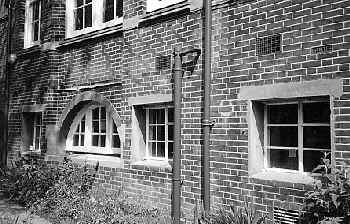 f each day was spent fully by the boys in
their own building. The other half was spent at the
Parochial Hall, the Meadvale Hall, the school garden, in
the playground or on the common for games.These
conditions prevailed until Spring of 1940 when two of the
schools moved elsewhere, but still St John's Girls' had
only three classrooms instead of five and partial use of
the hall... f each day was spent fully by the boys in
their own building. The other half was spent at the
Parochial Hall, the Meadvale Hall, the school garden, in
the playground or on the common for games.These
conditions prevailed until Spring of 1940 when two of the
schools moved elsewhere, but still St John's Girls' had
only three classrooms instead of five and partial use of
the hall...To make more room for the children in the upper building part of the basement was made into an extra classroom. The lower square widows seen in the picture were put in for extra light. Air
raids Everyone
affected Teachers
and Railings |
|
| Pictures from the School's past | |||
| A football team of the 1930s. Stan Sharp is the only boy identified and is on the left of the front row. Mr Tarr is back left, Mr Bennett is back right. | A group of children on the common by the school c1920 with Carters Cottages in the background. The girl second from the right in the back row is Alice Atkins. | ||
| This image of the St John's
1922 football team also appears further up the page but
here all the boys can be named; from l-r they are: Back Row: Ernest Young, Frank Risbridger, Arthur Moore, Fred Elsey, Charles Hutton, Albert Wickens. Front Row: Sydney Loader, Charles Pearce, John Fenn, Joe Pickard, Lewes Miles, Harold Hewitt. Charles Pearce was Mayor of Reigate 1972-73. Charles Hutton worked at the Redhill Baths. Harold Hewitt became the Redhill Common Keeper. Arthur Moore worked on the TV Times for a number of years. Joe Pickard worked at the Redhill Gas Works. |
Mr Tarr and Mr Bennett again
appear with a team, this time the one that won the 1932
Elementary Schools Swimming Championship shield . On the
back of the photo the boys' names are written thus:
K.Jordan L.Dalton V. Foot M.Stapleton J. Goldsmith. Presumably the top two names are of the boys at the front and the lower three are of the boys at the back. |
||
| Presumably a girls' dance class, probably from the early 1930s | A class in the girls' school, date unknown. The classroom is now the staff room. | ||
| Another picture of the staff to
compare with the one earlier on this page.The staff
members from l-r are: Back Row: Mrs Nicholas, Mr Mole, Mr Weeds, Mr Ross, Mr Jones, Miss Willett. Front Row: Mrs Bonner, Mr Bennett, Miss Worcester. |
A boys' class of c1927. The boy 4th from the right in the middle row is Sydney Moore from Meadvale, no others known | ||
| A class at a Dover school c1922. Connections with St John's and Redhill are that the teacher is a young Mr Weeds and the boy sixth from the left in the back row was to become the chief projectionist at the Odeon cinema (see information on the Odeon on the Station Road East page on this website ). (Photo Mick Betts)) | |||
| In the background is the old upper building, which was demolished in 1909/10 so this picture of the school drawn up for empire Day is probably between 190% and 1909. In the left foreground is headmaster Mr Jinks | Empire Day 1917. In the foreground is one soldier and three young men in civilian clothes. All are possible wounded servicemen as young men who had not volunteered were not readily accepted in society at this time. | ||
| Nothing is known about the St
John's Institute but here is its 1909-10 football team
(see also picture right) (Photo courtesy Roy Styles) |
St John's was the winner of the Surrey Mirror Shield at the end of the 1910-11 season. School teams taking part were St John's, St Matthew's, Cromwell Road, Hooley and Frenches. Note that the reverend gentleman in the background is the same as in the picture left. | ||
| The year is unknown but when the St John's Boys' swimming team won the Borough Elementary Schools' Arthletic Championship Shield it was the seventh time in eleven years that it had done so. | Headmaster Mr Jinks with a large class of boys and a sports theme. Picture probably from the early 190%s. | ||
| Empire Day 1912 | Girls at the maypole | ||
| Winners of the 1911 Swimming Shield | |
| Email from Glyn, I can also remember my first day at school. I can recall being taken up the steep path into the playground and then left crying my eyes out. Up till then I had enjoyed my freedom of long days playing in the garden in the hot summers we seem to have had then. On my first day I was led upstairs into room over looking the playground and I seem to remember being enthralled at the lovely bright colours of a counting frame obviously a strategy to help take ones mind on how to escape and go home with mum. If I recall the main hall was divided into classrooms which for assembles the folding dividers were pushed back to make a large hall. The desks had lids so you could put your exercise books in and had inkwells which we actually used, this was just before the start of biro's. Wet days we had playtimes in our class rooms and as an avid reader of anything and everything there was a large selection of comics and books for such days. In the summer we were allowed on the grass slope (sometimes banned if someone strayed out of bounds) and there we would race our Dinky and Corgi cars down the sandy tracks. Playing marbles was the big thing, but until I got the hang of swapsies I must have given away some really good ones for rubbish. Then straight after the summer holidays it was 'conker time' and on the way home from school there was a huge Chestnut Tree which we would lob sticks into to knock the conkers down, rush home find a skewer and thread them on string for the next day. The teachers in those days were very strict and the worse punishment was the cane, well I was no different than most and probably deservedly got my fair share of it. I believe we were given choice, hands or bottom (both hurt!) We were given free milk at playtime, something I hated but we were made to drink it. Sometimes as a monitor we had to do the washing up for the teachers, cups & saucers from their tea breaks which was good as you missed part of the lessons. I recall how we had to stand up in front of the class and recite our times tables (which went up to 12 as it was pounds, shillings and pence in those days. We had a garden pond in the school grounds and I loved our nature studies looking for frogs and newts. The sloping concrete air raid shelter on the outside of the playground served as a refuge, castle or fort and had great times trying to keep others from getting up there, also a large prickly tree we used to climb and sit in the branches during lunch times right outside the canteen area.
When we had swimming lessons we all had to troop down to Redhill Baths which was opposite Redhill Park. I slipped and nearly drowned on one of these lessons so it put me off learning to swim until my early twenties. Games and cricket were held on Redhill common on the Lawns which was kept very well maintained by the Common Keeper; we had all our Annual Sports days over there. Not far from Mill Street another very steep hill on the other side of the road. In the winter we sledged down there and believe me it was fast and scary (I like others who could not afford a real sledge had a metal tray, worked the same but you couldn't steer) It was a lovely walk to and from school as I only lived on The Cutting, Brighton Road so I went past St. Johns Church and through the alleyway and I was home. Good days, bad days I can recall but on the whole the best school I ever went to. I do remember one event over everything else and a teacher who I really liked (Mr. Loft ?) died and they played Greensleeves in his memory at assembly shortly afterwards ... that tune has always choked me up when I hear that played but he was a lovely teacher and it must have upset me being so young. That's
my basic memories I'm sure I could recall lots more but
those days are now a long way off.. Although you were twelve years after me it is astonishing how similar our St John's experiences were. Thank you for sending them in. And I agree, it was a long time ago, and getting longer. AJM |
|
| Since the book on St John's History was begun in 2001 there have been a number of significant events, none more so than the opening of the boys' WW2 air raid shelter in 2003 and the discovery of the 1940 murals on its walls. | ||
| 121101 | ||

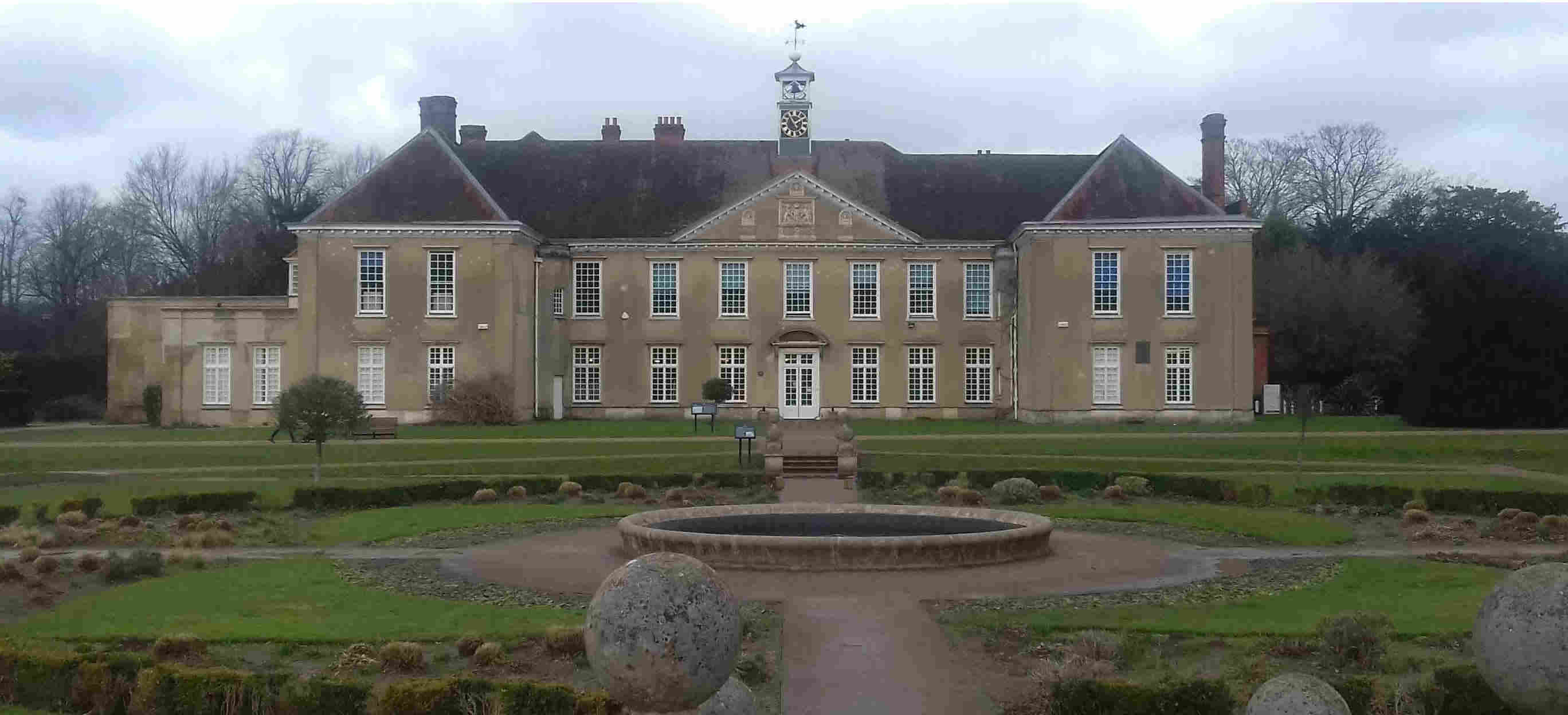
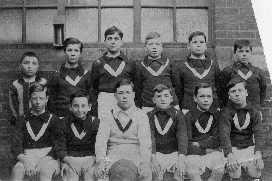 Many years ago a
special day called Empire Day was celebrated annually.
Many of the local schools assembled on the common by Mill
Street and were addressed by the Mayor of the Borough of
Reigate. Charlie Pearce was a pupil at St John's and
would have gone to the Empire celebrations on the common
and with all the other children listened to the Mayor.
What he could not have dreamed of then (or perhaps he
did) was becoming Mayor of Reigate himself one day,
something he achieved when he became the 50th Mayor in
1971-72.
Many years ago a
special day called Empire Day was celebrated annually.
Many of the local schools assembled on the common by Mill
Street and were addressed by the Mayor of the Borough of
Reigate. Charlie Pearce was a pupil at St John's and
would have gone to the Empire celebrations on the common
and with all the other children listened to the Mayor.
What he could not have dreamed of then (or perhaps he
did) was becoming Mayor of Reigate himself one day,
something he achieved when he became the 50th Mayor in
1971-72. 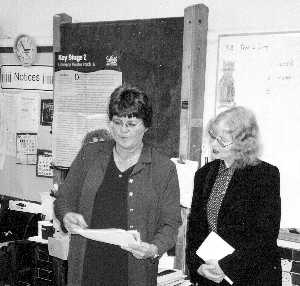 . ...
. ...